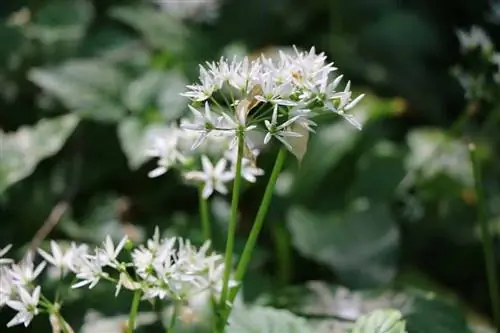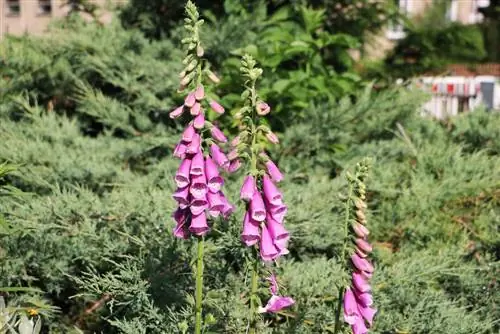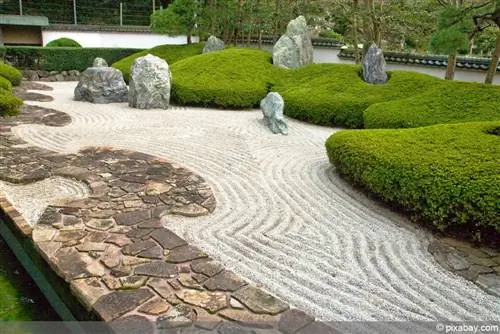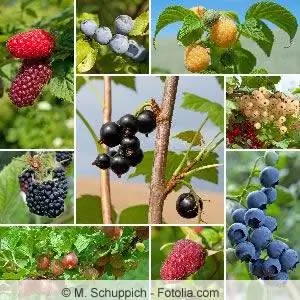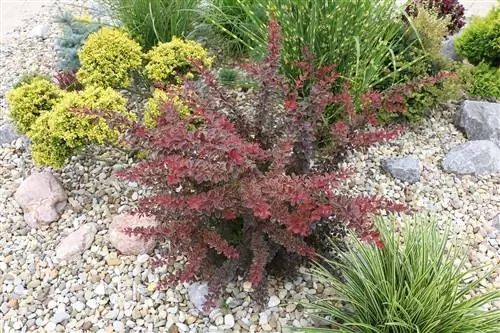- Author admin [email protected].
- Public 2023-12-17 03:39.
- Last modified 2025-01-24 12:45.
You have purchased a property near the forest and want to create a forest garden? A forest garden resembles a naturally grown forest. Every plant, every shrub and every tree forms important building blocks in the interaction of a forest garden. If you follow our tips for choosing plants, your forest garden will become an oasis for people and animals.
The special challenges of a forest garden
Before purchasing individual plants, plan the structure of your garden. Plants at different heights are required to recreate the natural shape of the forest. Are there trees already growing in your garden? If there are some coniferous and deciduous trees, perhaps even impressive old trees, they will give your garden an initial structure.
A forest garden is made up of plants of different heights:
- Trees
- Shrubs
- Hedges
- Perennials
- Ferns
- Groundcover
The soil in the forest garden
The nature of the soil is one of the biggest challenges when creating a forest garden. So that plants and trees feel comfortable and can develop well, the soil should contain humus. Check the condition of the soil and, if necessary, enrich it with bark humus, potting soil and compost soil. Covering with bark mulch protects the soil from drying out. Adequate moisture is important for a forest garden. We recommend adding bark mulch to the ground every ten to twelve weeks. This keeps it moist and creates a soil quality that is similar to that of the forest.
The trees in the forest garden
“In a forest garden the trees set the tone, how could it be otherwise?”
Trees take a long time to grow well and a few years to reach the desired size. Forest gardens are not for sun worshipers! Large trees in particular cast a lot of shade. Note that trees require a lot of moisture and nutrients. Other plants must be chosen carefully and suitable for the conditions in close proximity to trees and shrubs. For new planting, choose varieties that are native to your region. If you plant the trees on the edge of the property, they will create a good finish.
Trees suitable for a forest garden
Deeproots
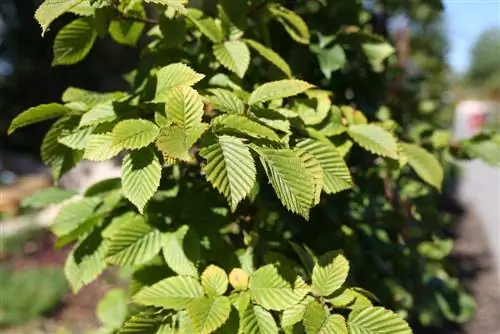
These trees form deep roots and can be easily planted under.
- Beech
- Oak
- Pine
- Apple trees
Shallow-rooted

These trees form strong, shallow roots. Other plants have a very difficult time under these trees.
- Birch
- Horse Chestnut
- Maple
- Spruce
Hedges and shrubs for the forest garden
The common holly (Ilex aquifolium)
Holly, with its leathery dark green leaves and bright red berries, is a must in a forest garden. They grow in European deciduous and coniferous forests. Holly trees grow between two and twenty meters tall and can live for several hundred years. Holly thrives in humus-rich soils. The fruits of the common holly are poisonous. Caution is advised when smaller children are running around in the forest garden.
The cherry laurel (Prunus laurocerasus)
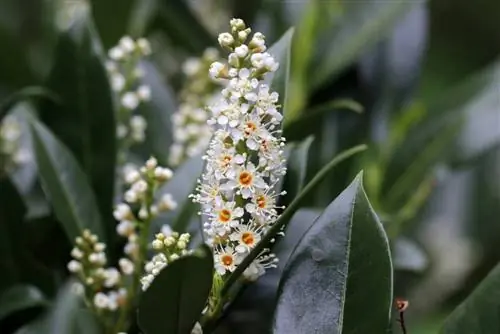
Cherry laurel hedges are very popular in forest gardens. They grow quickly, are frost-resistant and robust. Cherry laurel hedges are opaque and grow very evenly. They reach a height of up to 50 centimeters. Cherry laurel blooms from May to June and impresses from August onwards with initially red and later black-blue berries. The location for cherry laurel should be shady to partially shady. It grows excellently under trees and is ideal for creating a forest garden.
Perennials for the forest garden
The Lupine (Lupinus)
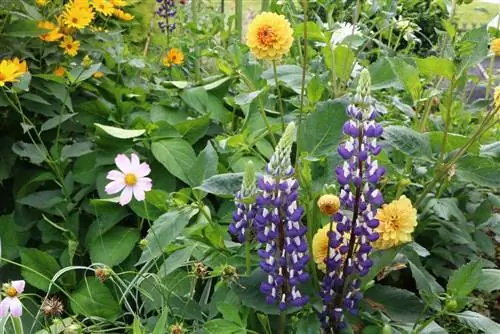
The lupine is a suitable plant for your forest garden. The perennial is extremely undemanding. It prefers sunny locations, but can also thrive in partial shade. It stays smaller in partial shade. Lupins have almost no demands on the soil. Even the most difficult soil is penetrated by the long lupine roots. Lupins are used as green manure and are among the soil improvers. Lupins are available in many colors from pink to blue, purple, white and even yellow.
The fragrant fleshberry (Sarcococca humilis)
The fragrant fleshberry is also calledShadowflower. It is one of the medium-tall perennials and fits perfectly into a forest garden. The small white flowers are inconspicuous. They appear in winter and exude a lovely honey scent. Black berries form from the flowers in spring. These are inedible, but look very decorative. The fragrant fleshberry prefers shady to semi-shady locations. It makes a beautiful underplanting for hedges and bushes in your forest garden. The shade flower forms densely branched bushes about 40 centimeters high.
Bee pasture (Phacelia)
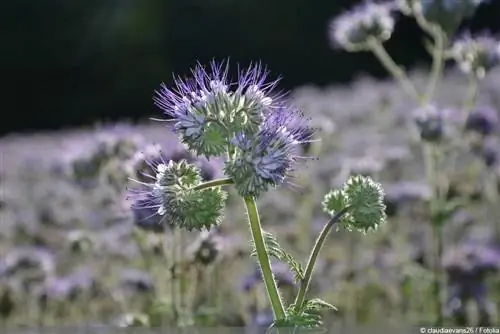
Phacelia is a popular bee plant. Every beekeeper and nature lover should have some Phacelia plants in their garden. The bees reward the small effort in many ways with their pollination services. The Phacelia is a green manure plant. It is undemanding and improves the soil. Phacelia suppresses weed formation. There are currently no known Phacelia pests, which is also a plus point for the bright blue flowering bee plant. The annual plant can be incorporated into the soil for fertilization after flowering.
The Foxglove (Digitalis)
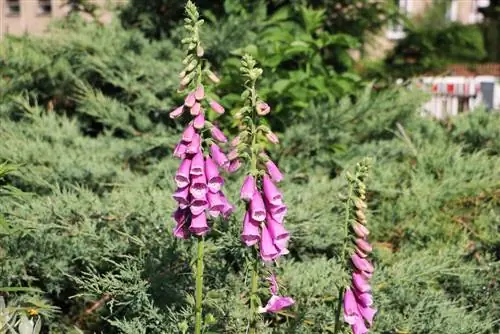
Just like in the natural forest, the foxglove should not be missing in the forest garden. There are around 25 different species of foxgloves in Europe. The most famous is the red foxglove, which is often found in forests and clearings. Foxglove is a biennial plant that reproduces easily through self-sowing. Foxglove prefers partially shaded locations. It thrives on low-lime, nutrient-rich, moist soils.
Note:
The foxglove is poisonous. If children play in your garden, you should avoid foxgloves.
Ferns for your forest garden
The Japanese ornamental fern
Ferns are a must in a forest garden. The Japanese ornamental fern is very decorative. With red stems and fern fronds that appear dark blue in the middle and silvery-white at the tips, the Japanese ornamental fern is an eye-catcher in every garden. Despite its extravagant appearance, the fern does not place high demands on its location. It prefers shady and semi-shady places and is therefore one of the plants intended for a forest garden. The decorative fern is hardy and reaches a height of around 40 centimeters.
Ostrich Fern (Matteuccia struthiopteris)
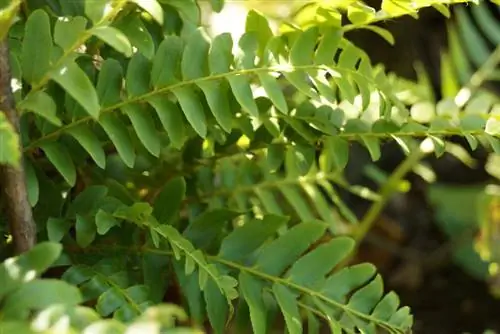
Ostrich fern should not be missing in a forest garden. It is a very decorative fern and is one of the fern species worth protecting. Buy the ostrich fern from the nursery and contribute to the preservation of the species. Ostrich fern thrives in moist soil in shade or partial shade. It grows up to 1.20 meters high and is well suited for underplanting trees and bushes.
Ground cover plants for your forest garden
Siberian storksbill (Geranium sibiricum)
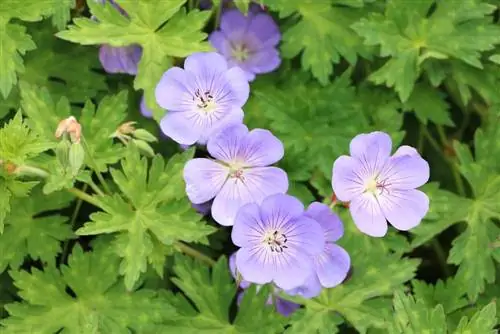
The Siberian cranesbill is ideal as a ground cover in the forest garden. The plant is easy to care for and thrives best in partial shade. The Siberian cranesbill protects against the emergence of weeds. It is very decorative with green leaves streaked with dark red veins. The flowers appear numerous in purple. The Siberian cranesbill impresses with its beautiful autumnal leaf color.
Small Periwinkle (Vinca minor)
Periwinkle is a must in a forest garden. Periwinkle is a wonderful ground cover. You can get the small periwinkle in different versions from specialist retailers. The blue-flowering variety of Vinca minor “Marie” and the white-flowering “Elisa” are well known. The small evergreen is suitable for sunny and semi-sunny places. It also thrives under trees as long as the light supply is assured. It forms even carpets and requires little maintenance. You should prune the periwinkle annually so that strong plants can form.
Ivy (Hedera helix)
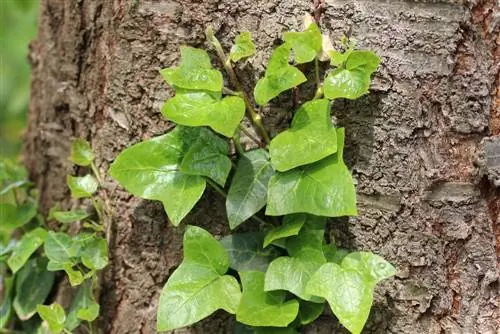
Ivy is the number one climbing plant in mixed oak and beech forests. At the same time, ivy is ideal as a ground cover. It grows well on rocky surfaces. Ivy can climb up to 20 meters high and live up to 500 years. The leaves are evergreen. Some varieties show a reddish foliage color in autumn.
Ivy prefers shady, moist locations. The plant is undemanding and thrives particularly well in humus-rich soil. Ivy does not require fertilization, but should be pruned from time to time.


